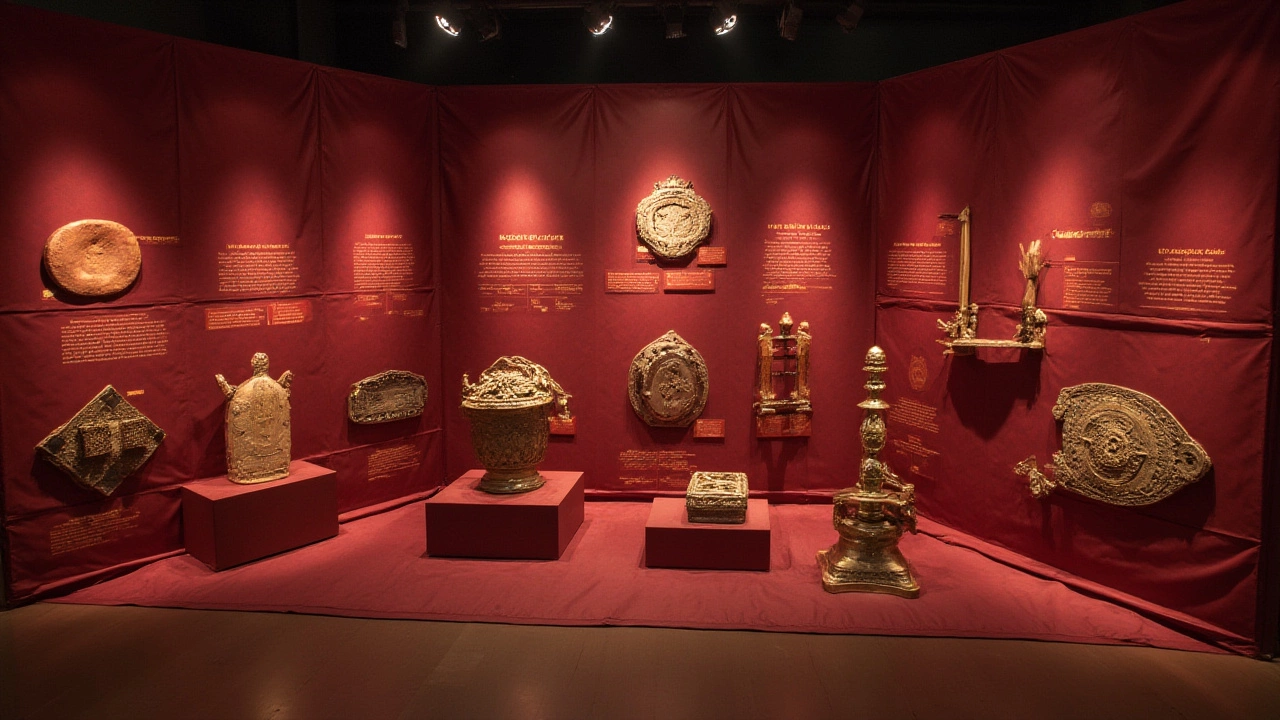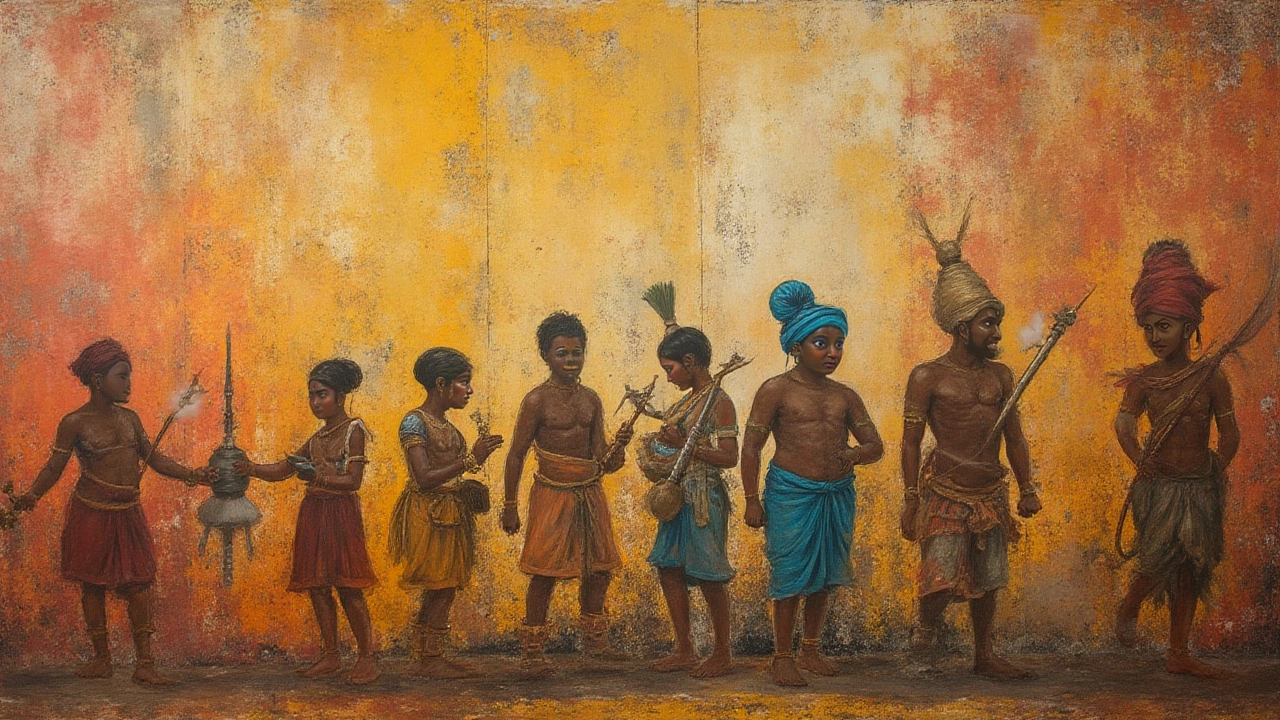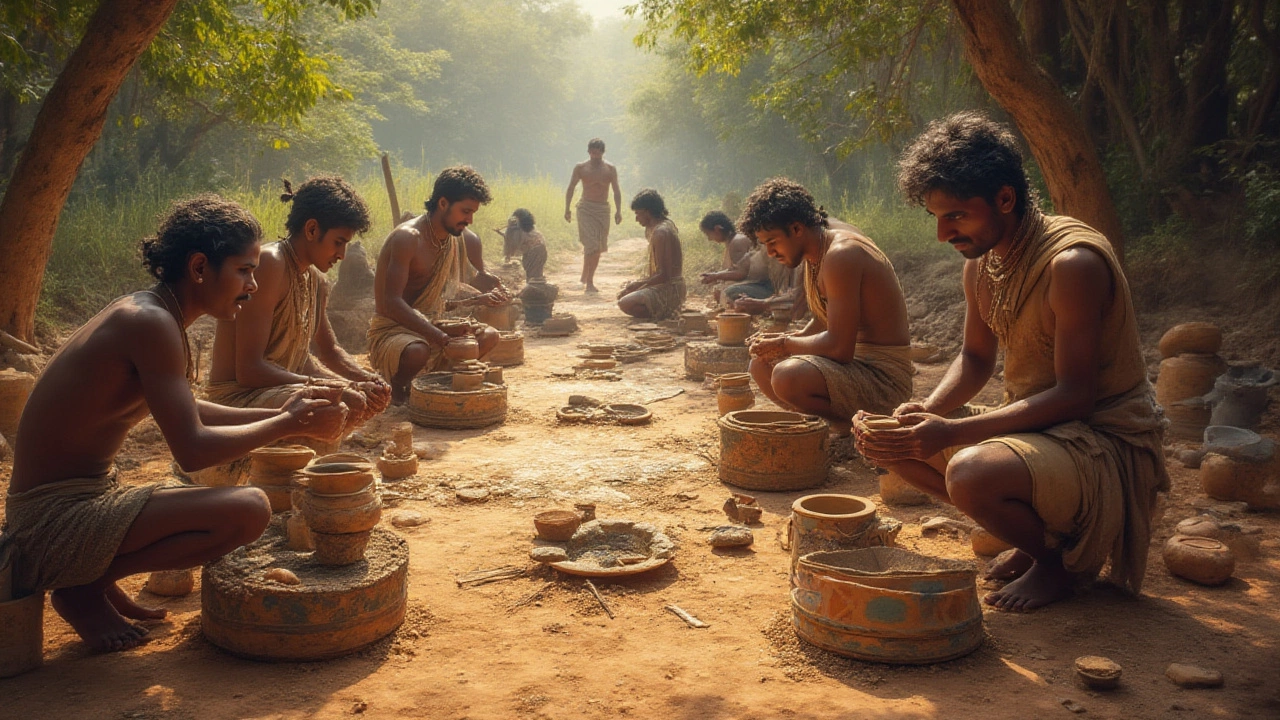Archaeologists found something wild in the dusty sands of Lothal and Mehrgarh: clay pots older than your wildest guess, etched with designs that feel both strange and oddly familiar. That’s just a sliver of what India’s very first handicraft looked like, setting the tone for thousands of years of creative chaos, skill, and beauty. Most folks think of block-printing or intricate woodwork when they hear 'Indian handicraft,' but the roots go way, way deeper— back to days when metal was a fantasy, and humans barely had words for beauty.
The Earliest Evidence of Indian Handicrafts
So what exactly was the first Indian handicraft? The oldest traceable craft comes from pottery unearthed at sites like Mehrgarh in present-day Pakistan, pushing back the clock to around 7000 BCE. Imagine communities settling down, trading in their nomadic ways for fields of barley and wheat, and suddenly, the urge to create struck. Instead of just shaping pots for utility, they smudged geometric patterns onto wet clay before firing it up in primitive kilns. These weren't just hunks of mud— they marked the beginning of India’s artful handiwork.
The numbers are kind of crazy. At Mehrgarh, over 4,000 fragments of painted and plain ceramics were found. The shapes? Everything from storage jars to decorative bowls. It wasn’t a few bored farmers. An entire community had grabbed onto this craft. The fixing of handles, making ridged bases for grip, and painting red bands and chevrons— all done without spinning wheels, just nimble hands and a whole lot of patience.
But let’s talk about Harappa and Mohenjo-daro, two names that pop up in the story of Indian civilization. Around 2500 BCE, these Indus Valley cities had skilled craftspeople working on pottery, beads, dice, toys, and copper tools. In fact, a small bronze dancer— not much bigger than your palm— was cast using the lost wax technique. She still stands with her hand on her hip, as if utterly bored with time itself. This figurine is one of the earliest known examples of metal artistry, and she’s now legendary. You’ll find statements in art history textbooks that claim India’s Indus Valley folks were among the best craftspeople of their era. That’s not an exaggeration.
The tools found at these ancient digs tell an even bigger story. Archeologists uncovered spinning whorls, weights for looms, bone needles, and truly delicate beads made from carnelian—a reddish gemstone, ground and drilled by hand. The sheer technical skill is mind-blowing, especially when you consider the tools were just bone, stone, and a healthy serving of ingenuity.
Here’s a quick look at some of the earliest Indian handicrafts and their key facts:
| Handicraft | Location | Approximate Date | Material | Techniques Involved |
|---|---|---|---|---|
| Pottery | Mehrgarh | 7000 BCE | Clay | Hand-formed, geometric painting, firing |
| Bronze Figurines | Mohenjo-daro | 2500 BCE | Bronze | Lost wax casting |
| Carnelian Beads | Harappa | 2500 BCE | Carnelian stone | Hand-drilling, polishing |
| Toy Carts & Dolls | Harappa | 2500 BCE | Terracotta | Molding, hand-finishing |
So which one deserves the title of "first Indian handicraft"? Pottery takes the crown by a few thousand years. Yet it wasn’t just clay and patience that lay at the foundation. Artistic hunger was there from the start, along with fingers itching to create something that lasted.

How Ancient Handicrafts Shaped Indian Culture
Handicrafts in early India did more than offer practical solutions for storage or cooking. They acted as mirrors of culture, religion, and the odd quirks of society. Think about pottery designs: those squiggly lines, zigzags, or carefully painted dots weren’t random. Many reflect river flows, fields in harvest, even cosmic patterns. And these marks didn’t fade away as new dynasties swept through; generations kept the tradition alive, passing techniques from mother to daughter or father to son.
Towns like Lothal, Dholavira, and Kalibangan became bustling centers for not just trading goods, but also ideas. Pottery wasn’t done in isolation—people gathered, swapped colors and shapes, and even created symbolic religious items. Some believe the thick-necked jars and sharp-edged bowls found in graves had ritualistic value, hinting at an early intertwining of daily life and spiritual beliefs.
The shift from stone to metal—and the leap it represented—was a game-changer. As the Bronze Age began, craftsmen discovered new uses for copper, bronze, and tin alloys. No more just pots and pans; now, they made mirrors, bangles, and weapons with flowery engravings. The most fascinating bit? The "Dancing Girl" from Mohenjo-daro: she’s both playful and sophisticated, showing that the urge to create beauty wasn’t a modern invention.
Textiles also crept into the story. Sure, we don’t have full ancient sarees saved from 4500 years ago, but spindle whorls and impressions on pots confirm that weaving was going on. Early Indian cotton was spun, dyed with natural extracts, and sometimes fire-colored with clay slips. Even back then, people cared about what they wore or how their homes looked.
Many folks don’t realize how much ancient Indian crafts influenced later traditions. The patterns from the Indus Valley reappeared in subsequent pottery from the Painted Grey Ware (around 1200 BCE) and Northern Black Polished Ware (around 700 BCE), which eventually led to the decorative styles in the Mauryan and Gupta eras. The way crafts shaped society is also seen in these transitions. Crafts gave rise to guilds—called 'shrenis'—by the time of the Mauryans, setting the stage for community trade and keeping techniques alive even as kingdoms toppled.
Here are some cool tips if you’re ever at a museum or archaeological site:
- Look for geometric or animal designs on shards of pottery—these often mean the piece is prehistoric.
- If you see a glossy, black-finished bowl, that’s likely Northern Black Polished Ware, which was a few thousand years after Mehrgarh but still roots back to the same traditions.
- Beads made from carnelian, lapis lazuli, or agate often indicate ancient origins, especially with tiny perforations (they used a bow drill!).
- Simple tools like bone needles, terracotta figurines, or stone bangles are solid proof of handicraft traditions.
The bottom line is, ancient Indian handicrafts weren’t just products—they defined social and spiritual life. From how people traded to how they mourned their dead, crafts were everywhere. You can still find echoes today: handmade clay cups at tea stalls, block-printed fabrics in marketplaces, or terracotta toys in rural fairs—direct descendants of these earliest creations.

Old Techniques, Modern Echoes: Handicraft Lessons for Today
Jump to today—ask any potter in Khurja or a bead-maker in Varanasi, and you’ll hear that the basic principles haven’t changed much. Working with hands, firing in kilns, mixing natural colors: it all traces back to those first creative flickers in ancient India. What’s wild? Some families have practiced the same craft, using nearly identical tools and processes, for centuries. Techniques like hand-coiling, pinch pottery, or using a simple wooden wheel still thrive in parts of Gujarat, Rajasthan, and Bengal.
The biggest difference is exposure. Ancient artisans were masters of secrecy; now, every skill can trend on Instagram. But the real wisdom? It’s hidden in the “slow” process—waiting for a lump of clay to dry, letting natural dye set, or getting the shape at just the right moment. Patience ruled then, and it’s still the craftsman’s superpower today.
There are real numbers to back up this living tradition. The Indian government’s 2019 Handicrafts Survey documented over 68,000 unique craft clusters, employing nearly 7 million people. That’s not a niche—it’s a thriving backbone of rural and small-town economies. And a surprising amount of demand comes from global markets hungry for something with a story and soul, not just plastic trend-chasers.
So, how do you keep the spark alive in a world hooked to mass production? Here are some lessons from antiquity that still work:
- Respect the process. Ancient artisans bragged less about the finished product and more about getting each step right.
- Pass it down. Skills only survive when shared. This is why many Indian crafts are family-run, with secrets moving from one generation to the next.
- Use local, sustainable materials. Ancient pottery was made from dug-up river clay, colored with minerals, and fired with dried cow dung—no carbon-intensive factories needed.
- Blend tradition with personal quirks. Early Indus artists invented their own symbols and animal figures, and today’s artisans still add individual flair—sometimes even signing their pieces for the first time in centuries.
Let’s not forget—this first Indian handicraft isn’t some relic gathering dust. Indian pottery, beadwork, and metal crafts are still used for worship, decoration, and even daily chores. And they’re always evolving. Young designers are mixing ancient motifs with modern design—think mugs with Harappan patterns or sarees printed with thousand-year-old animal motifs.
The spark that started with painted pots in Mehrgarh hasn’t faded. It’s there in the smooth curve of a Jaipur vase, the pop of color in Kutch beadwork, and the gentle bend of a handcrafted spoon in a Delhi café. If you ever get your hands on a piece—whether it’s a rustic terracotta diya or an ornate bronze figurine—know you’re holding the legacy of India’s very first handicraft. It started simple, but it shaped a world of creativity that refuses to fade.
